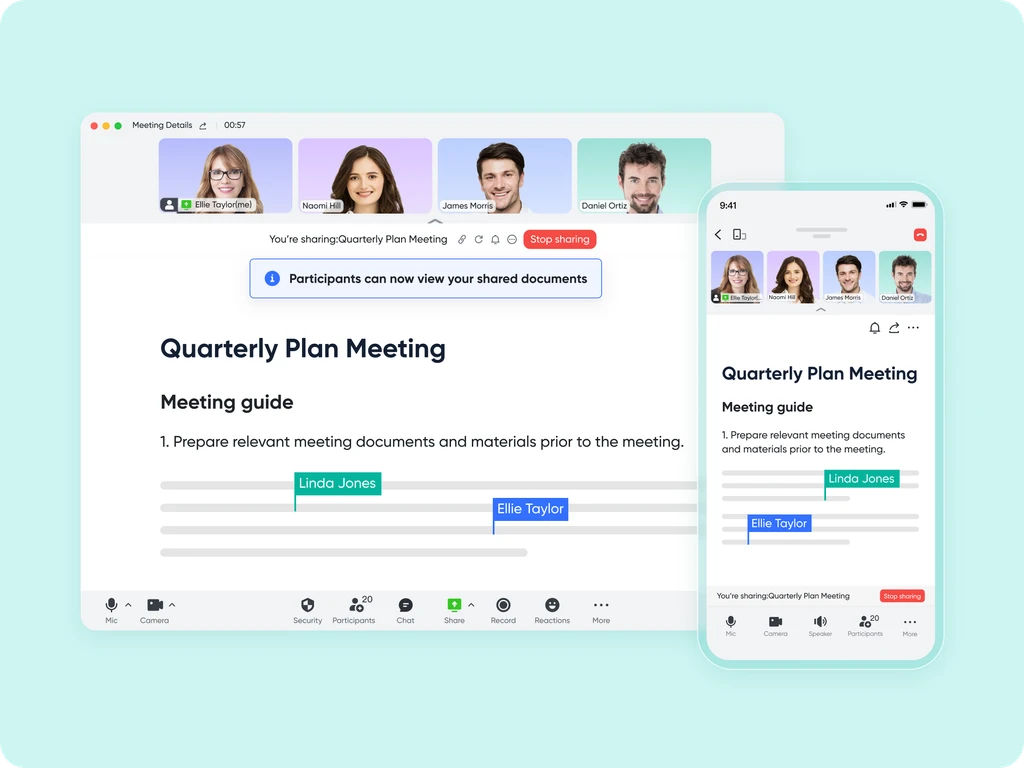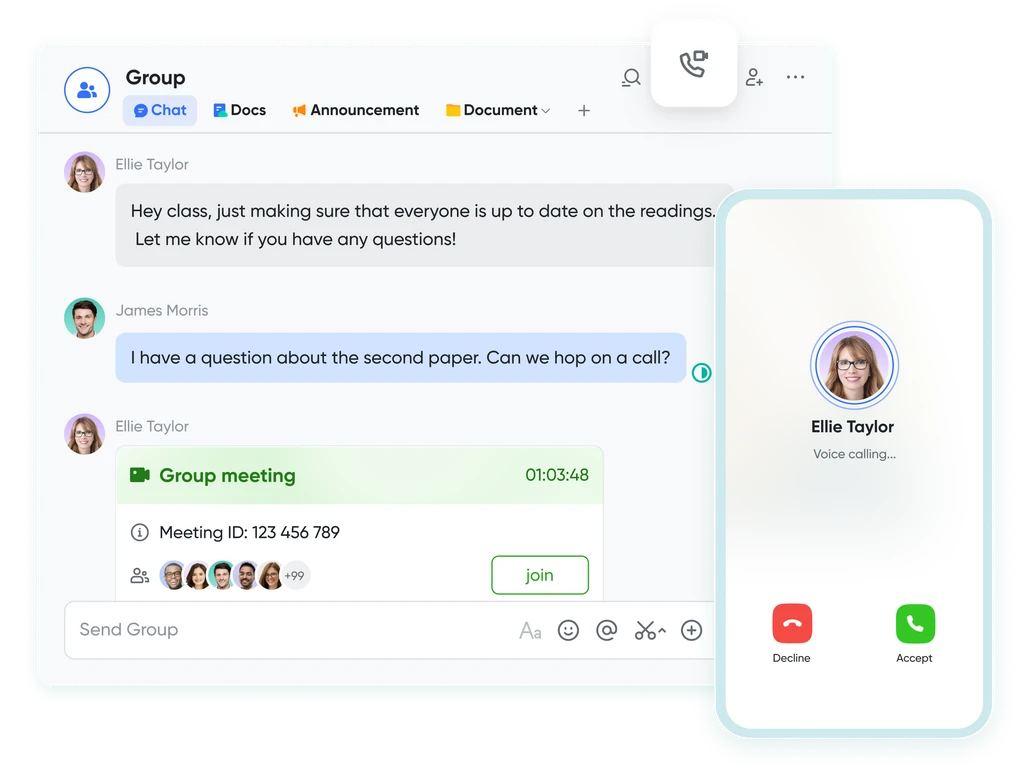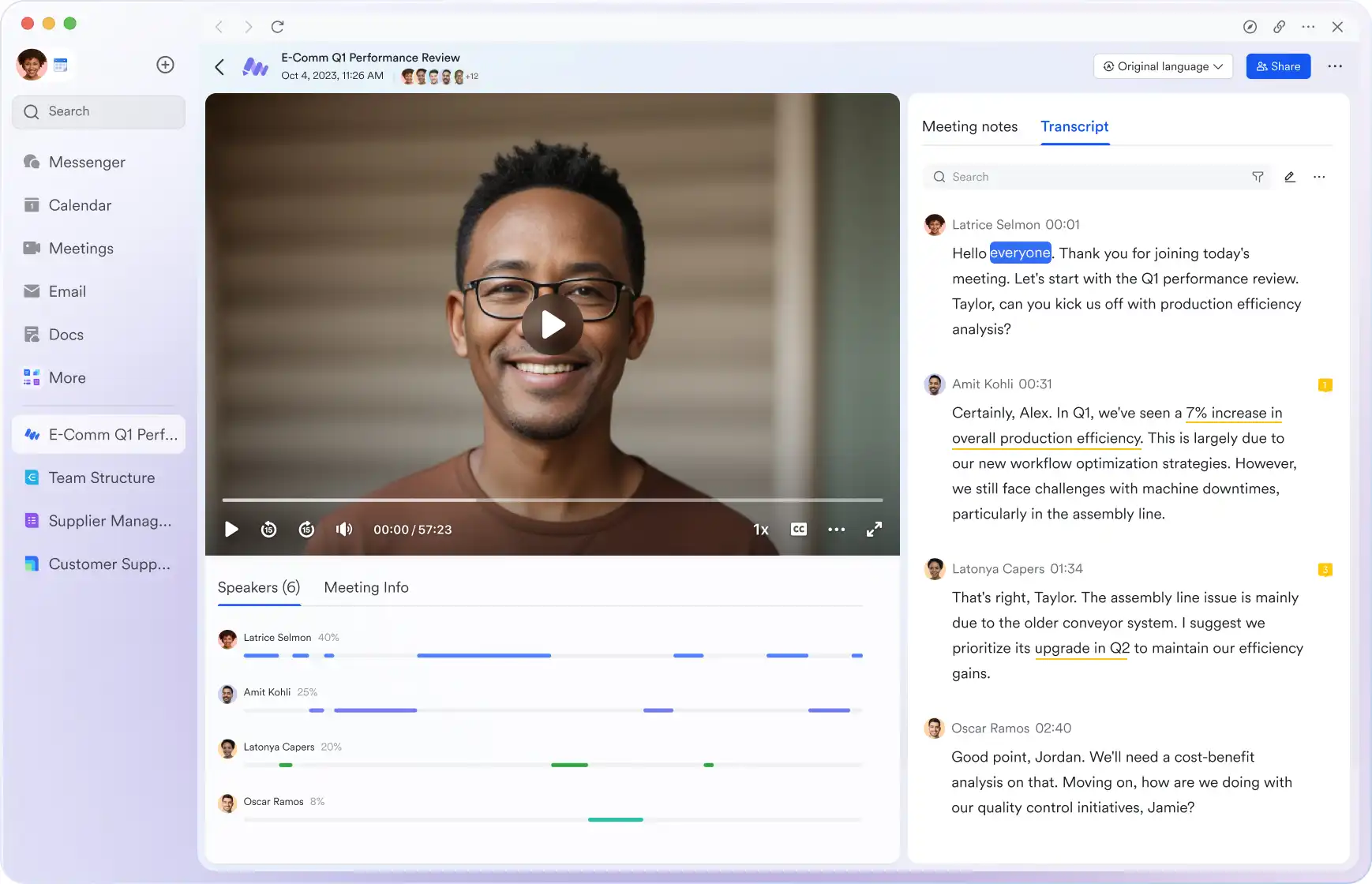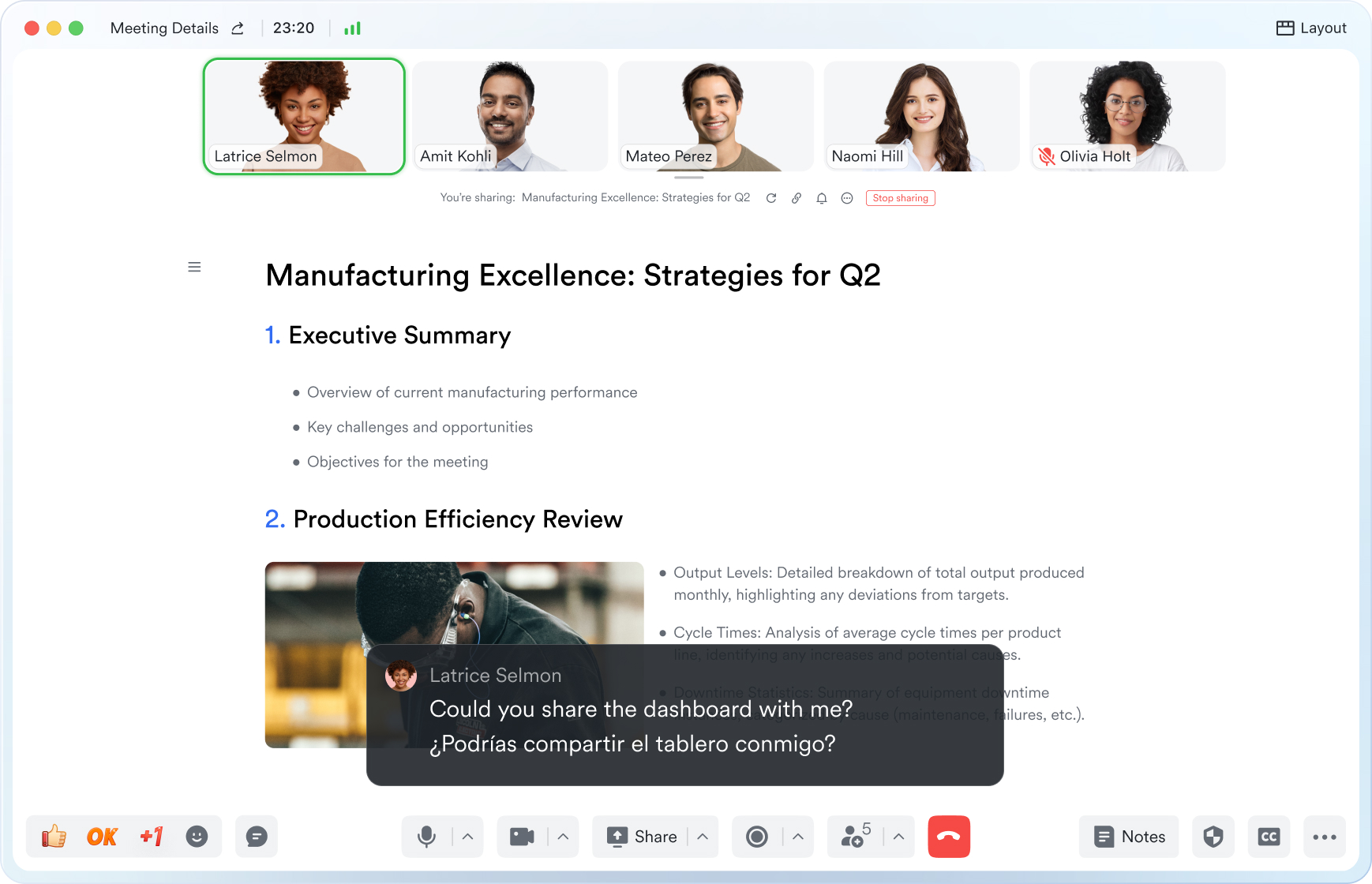Timeline Review Meeting
This guide will walk you through the essential elements of use timeline review meeting to keep your attendees aligned and engaged.
Try Lark for Free
Hosting a successful timeline review meeting is essential for effective project management and ensuring timely completion of tasks. In this comprehensive guide, we will explore the key elements of hosting a successful timeline review meeting, including its goals, participants, agenda, structure, and best practices for virtual settings. Additionally, we will delve into practical examples and common pitfalls, providing valuable insights to make your timeline review meeting a resounding success.
Use Lark Meetings to turn meetings into true collaborative experiences.
What is a timeline review meeting?
A timeline review meeting is a crucial aspect of project management, focusing on the review and assessment of project timelines and deadlines. It serves as a platform for stakeholders to discuss progress, identify potential delays, and realign project timelines where necessary. The primary purpose of this meeting is to ensure that the project stays on track and meets its deadlines effectively.
Goals of timeline review meeting
The primary goals of a timeline review meeting include:
- Assessing Progress: Reviewing the progress made on project tasks and milestones within the given timeline.
- Identifying Delays: Identifying any delays or roadblocks that may impact the project schedule and taking proactive measures to address them.
- Alignment: Ensuring that the project timeline aligns effectively with the overarching goals and deadlines of the organization.
- Actionable Takeaways: Generating actionable takeaways and strategies to optimize the project timeline and enhance efficiency.
Who should attend a timeline review meeting?
Key stakeholders, including project managers, team leads, department heads, and relevant team members, should participate in a timeline review meeting. Additionally, representatives from any external stakeholders, such as clients or vendors, who play a significant role in adhering to project timelines should also be involved. Each participant should contribute relevant insights and collaborate effectively to ensure the meeting's success.
Related:
Master the Art of Meeting Notes with Lark for Enhanced Collaboration | Lark Blog | Lark BlogLearn more about Lark x Meetings
Topics, agenda, and structure of timeline review meeting
The agenda for a timeline review meeting should encompass several key components, including:
- Review of Milestones: Assessing the completion status of major project milestones.
- Identifying Bottlenecks: Discussing any bottlenecks or obstacles that are hindering the timeline.
- Resource Allocation: Evaluating the allocation of resources and identifying any potential resource constraints.
- Risk Assessment: Reviewing any potential risks or external factors that may impact project timelines.
The meeting structure should provide ample time for in-depth discussions on each agenda item, allowing for comprehensive assessments and actionable outcomes.
Learn more about Lark x Meetings
How often does a timeline review meeting occur?
The frequency of timeline review meetings may vary based on the project's complexity, duration, and the need for regular assessments. Typically, these meetings are held weekly, bi-weekly, or monthly, depending on the project's critical timelines and the pace of activities. However, the frequency should be adjusted based on the project's evolving needs and requirements.
Key differences between timeline review meeting and another similar meeting
A timeline review meeting differs from other project meetings, such as status meetings or sprint planning meetings, in its sole focus on assessing the project timeline and milestones. While status meetings may encompass broader project updates, the timeline review meeting is specifically aimed at evaluating progress against the project schedule.
Related:
Unlock the Power of Webinars: A Comprehensive Guide to Boost Your Business | Lark Blog | Lark BlogLearn more about Lark x Meetings
Three practical examples of timeline review meetings
Scenario 1: large-scale construction project
Scenario 1: large-scale construction project
In a large-scale construction project, a timeline review meeting may involve reviewing the progress of key construction phases, ensuring adherence to the project schedule, and addressing any potential delays arising from unforeseen circumstances or material shortages.
Scenario 2: software development project
Scenario 2: software development project
For a software development project, a timeline review meeting may focus on sprint timelines, code integration milestones, and the impact of any technical challenges on the overall project schedule.
Scenario 3: marketing campaign rollout
Scenario 3: marketing campaign rollout
In the context of a marketing campaign rollout, the timeline review meeting may revolve around assessing the launch timelines, content creation milestones, and coordinating promotional activities to meet the planned campaign rollout date.
Common pitfalls of a timeline review meeting
Some common pitfalls associated with timeline review meetings include:
- Lack of Preparation: Inadequate preparation by participants leading to unproductive discussions and incomplete assessments.
- Limited Accountability: Failure to assign clear responsibilities and action items, resulting in unresolved issues post-meeting.
- Overlooking External Factors: Neglecting to consider external factors that may impact the project timeline, leading to unforeseen delays.
Learn more about Lark x Meetings
Dos and don'ts of a timeline review meeting
| Dos | Don'ts |
|---|---|
| Clearly define the meeting objectives | Don't allow prolonged discussions on irrelevant topics |
| Encourage active participation from all attendees | Don't ignore potential risks and roadblocks |
| Document actionable outcomes and follow-up plans | Don't dismiss concerns raised by team members |
| Review past action items and their impact | Don't rush through agenda items without in-depth discussion |
What makes a virtual timeline review meeting successful?
A virtual timeline review meeting's success hinges on leveraging the right technological tools, encouraging active participation, and maintaining a structured approach to discussions. Facilitating seamless virtual interactions and maximizing engagement plays a crucial role in the success of these meetings.
Learn more about Lark x Meetings
Typical takeaways of the timeline review meeting
The takeaways from a timeline review meeting typically include:
- Action Items: Clearly outlined action items with assigned responsibilities and deadlines.
- Revised Timelines: Potential adjustments or realignments in project timelines based on the meeting discussions.
- Risk Mitigation Strategies: Identified strategies to mitigate potential risks impacting the project schedule.
Questions to ask in the timeline review meeting
Asking the right questions is pivotal in ensuring productive discussions in a timeline review meeting. Some key questions to consider include:
- Are there any foreseeable obstacles that could potentially impact the project timeline?
- What measures can be taken to address any existing delays or roadblocks affecting the project schedule?
- Have all necessary resources been allocated to meet upcoming project deadlines effectively?
Learn more about Lark x Meetings
Conclusion
Hosting a successful timeline review meeting requires meticulous planning, active participation, and a commitment to addressing challenges proactively. By adhering to best practices and leveraging effective collaboration, organizations can streamline project timelines and ensure successful project delivery.
Use Lark Meetings to turn meetings into true collaborative experiences.
A Game Changer for Timeline Review Meeting: Empower your team with Lark Meetings
In the fast-paced and dynamic world of modern business, effective communication and collaboration are crucial for success of Timeline Review Meeting. Here we introduce Lark Meetings to serve as a centralized hub for all communication needs.
Transform your meetings into collaborative endeavors

Leverage the potency of in-call document sharing, intelligent meeting minutes, and mobile-optimized features to enhance productivity collaboratively, irrespective of your location or schedule.
Seamlessly collaborate in real-time, across any device

Share live documents instead of just screen views. Participants can navigate and edit simultaneously within the video call window, even while on the move.
Shift your focus to engagement, not note-taking

Lark Minutes automatically converts video meetings into transcripts, facilitating easy viewing, searching, and collaborative editing. Stay in the loop asynchronously, even if you can't attend the live meeting. Lark Minutes for meeting minutes support translation into 10+ different languages.
Break language barriers in communication

Lark Meetings provide real-time translation for subtitles, allowing individuals from diverse backgrounds to express themselves in their native languages. Ensure every voice is heard, regardless of geographical location. Live subtitles currently support translations from English, Chinese, and Japanese to 10+ different languages. See more translation feature in Lark.
Connect with larger audiences
Host dynamic online meetings and events accommodating up to 1,000 participants, with the flexibility of up to 50 breakout sessions for intimate group discussions within the larger meeting context. Try more Lark features for free.








